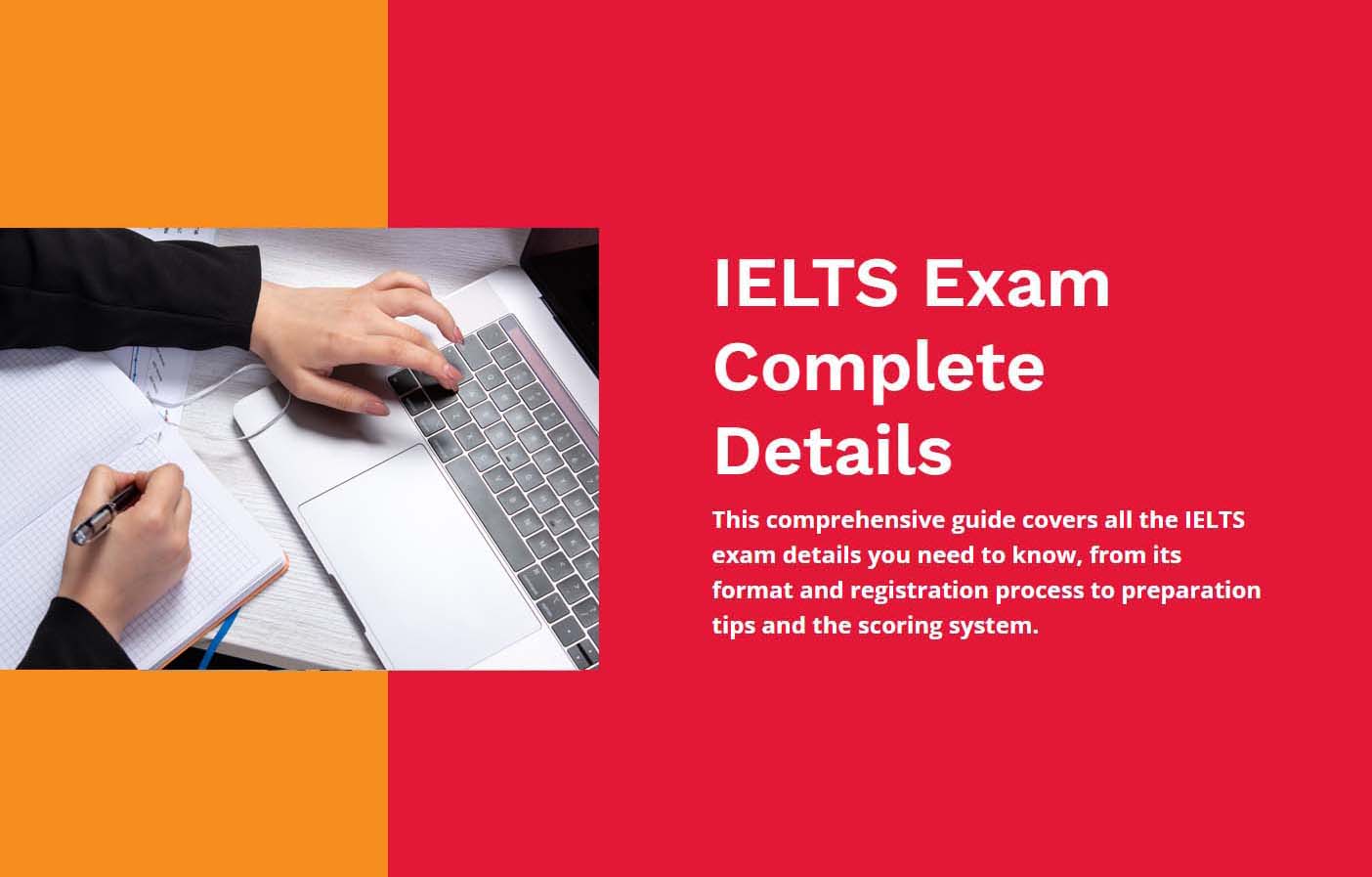Introduction
The International English Language Testing System (IELTS) is more than just a language exam—it’s your gateway to global opportunities. Recognised by over 11,500 organisations across 140+ countries, including universities, immigration authorities, and employers, IELTS is a trusted benchmark for English language proficiency.
Whether you’re aiming to study at a top university abroad or planning to work or migrate to an English-speaking country, understanding the IELTS exam is essential. This guide breaks down everything you need to know: exam format, registration steps, preparation strategies, scoring insights and key updates for 2025.
What is the IELTS Exam?
Types of IELTS Tests
1. IELTS Academic:
2. IELTS General Training
3. IELTS for UKVI
| Test Type | Purpose | Required For |
|---|---|---|
| Academic | Higher education or professional registration | Universities, professional bodies |
| General Training | Migration, work or training programmes | Immigration to UK, Canada, Australia, New Zealand |
| UKVI | UK visa and immigration purpose | UK visa categories like Tier 2, family, settlement |
Importance of the IELTS Exam
The IELTS exam holds significant weight for those pursuing education, career opportunities, or relocation in English-speaking nations. In the UK, universities such as the University of Manchester and King’s College London frequently require a competitive IELTS score for admission, while visa applications—whether for study or skilled employment—also hinge on these results. Similarly, in Australia, the test serves dual purposes, aiding both university applications and skilled migration processes. Canada’s Express Entry system for permanent residency places considerable emphasis on IELTS scores, as does New Zealand’s criteria for academic enrollment and skilled migration. Whether applying for postgraduate studies or professional roles in fields like healthcare or engineering, a strong IELTS performance can streamline the journey, fulfilling both language proficiency and visa prerequisites in one step.
IELTS Exam Format
Listening
The listening section lasts for 30 minutes and consists of four recordings. However, the candidates are entitled to another 10 minutes to transfer their answers. The total number of questions asked in this section is 40. Candidates listen to each recording once and answer questions as they listen. This section tests a range of listening skills, including understanding main ideas and detailed factual information, recognising speakers’ opinions, attitudes, and purposes, and following the development of an argument.
- Recording 1: A conversation between two people set in an everyday social context (e.g., a conversation about travel plans).
- Recording 2: A monologue set in an everyday social context (e.g., a speech about local facilities).
- Recording 3: A conversation between up to four people set in an educational or training context (e.g., a discussion between students and a tutor).
- Recording 4: A monologue on an academic subject (e.g., a university lecture).
Common Question Types
| Section | Description | Question-Types and Strategies |
|---|---|---|
| Section1 | A conversation between two people in a social context (e.g., booking a hotel). | Common question types include form completion, short-answer, and table completion. Use bullet-point notes. |
| Section2 | A monologue in a social context (e.g., a talk on local services). | Expect map/labelling, matching, or multiple choice. Note keywords linked to locations or directions. |
| Section3 | A conversation involving up to four people in an academic/training setting. | Look out for matching opinions, sentence completion, and multiple choice. Use initials to track who says what. |
| Section4 | A monologue on an academic subject (e.g., a university lecture). | Likely question types include summary completion and note/table/flowchart completion. Use headings to organise notes. |
- Multiple Choice
- Matching
- Plan, Map or Diagram Labelling
- Form, Note, Table, Flowchart or Summary Completion
- Sentence Completion
- Short Answer Questions
Tips to Ace the Listening Section
| Section | Description | Tips |
|---|---|---|
| Section 1 | Conversation between two people in a social context | Listen for specific details and keywords. |
| Section 2 | Monologue in a social context | Focus on the main ideas and the speaker’s attitude. |
| Section 3 | Conversation in an educational or training context | Identify connections between different points. |
| Section 4 | Monologue on an academic subject | Pay attention to complex information. |
- Read the questions in advance to anticipate the kind of information you need to listen for.
- Focus on synonyms and paraphrasing—the language used in the audio may differ from the wording in the questions.
- Stay alert throughout, as answers often come in order but can be missed easily if you’re distracted.
- Don’t leave any blanks—there’s no penalty for incorrect answers, so always make an educated guess if unsure.
Reading
The reading section, lasting 60 minutes and including time for submitting answers, comprises three parts, each featuring a single extended text. The texts are authentic and are taken from books, journals, magazines, and newspapers. They are appropriate for test-takers entering university courses or seeking professional registration. The Reading section tests a wide range of reading skills, including reading for gist, for main ideas or detail, skimming, understanding logical arguments, and recognising writers’ opinions, attitudes, and purposes.
- Academic Reading: Includes texts from books, journals, and newspapers.
- General Training Reading: Features extracts from books, magazines, newspapers, notices, advertisements, company handbooks, and guidelines.
Common Question Types
| Section | Description | Question Types |
|---|---|---|
| Section1 | Features short texts on everyday topics such as notices, advertisements, and timetables. Designed to test your ability to locate information quickly. | Focus on matching information, true/false/not given, and sentence completion. Skim for keywords and scan for specific details. |
| Section2 | Contains workplace-related texts, such as job descriptions, training manuals, or company policies. Slightly more detailed than Section 1. | Look out for matching headings, multiple-choice, and short-answer questions. Understand the main ideas and the writer’s purpose. |
| Section3 | Involves a longer, more complex text on a topic of general interest—often academic in tone. This section tests higher-level comprehension skills. | Expect summary completion, matching features, and identifying the writer’s view. Focus on arguments, tone, and logical flow of ideas. |
- Multiple Choice
- Matching Headings
- Matching Information or Features
- Sentence or Summary Completion
- True/False/Not Given or Yes/No/Not Given
- Flowchart/Table/Diagram Completion
- Short Answer Questions
Tips to Succeed in Reading
| Section | Description | Tips |
|---|---|---|
| Section1 | The texts deal with everyday topics, such as notices, advertisements, and timetables. You need to pick out important information. | Listen for specific details and keywords. |
| Section2 | The texts focus on work-related topics, such as job descriptions, contracts, staff development, and training materials. | Focus on the main ideas and the speaker’s attitude. |
| Section3 | The text deals with a topic of general interest, is generally descriptive and instructive, and is longer and more complex. Sources include newspapers, magazines, books, and online resources. | Identify connections between different points. |
- Skim the passage first to get a general idea before diving into questions.
- Highlight keywords in the questions and scan the text to locate them or their synonyms.
- Time management is key—spend no more than 20 minutes per passage.
- Read instructions carefully, especially when answering True/False or matching-type questions.
- Don’t overthink ‘Not Given’ questions—if information isn’t there, move on confidently.
Writing
The Writing section lasts for 60 minutes and is divided into two tasks. Candidates are assessed on their ability to write an appropriate response in terms of content, format, and language.
| Task | Question Types | Timing and Word Count |
|---|---|---|
| Task 1 | Academic: Line graph, bar chart, pie chart, table, map, process diagram General: Formal, semi-formal or informal letter | Spend 20 minutes Write 150–170 words |
| Task 2 | Opinion, discussion, problem-solution, advantages/disadvantages, two-part questions | Spend 40 minutes Write 260–280 words |
- Academic Writing:
- Task 1: Candidates are presented with a graph, table, chart, or diagram and asked to describe, summarise, or explain the information in their own words.
- Task 2: Candidates are asked to respond to a point of view, argument, or problem with a well-structured essay.
- General Training Writing:
- Task 1: Candidates are presented with a situation and asked to write a letter requesting information or explaining the situation.
- Task 2: Candidates are asked to write an essay responding to a point of view, argument, or problem.
Tips for Success:
| Task | Description | Tips |
|---|---|---|
| Task 1 | Descriptive/Letter Writing | Plan your structure before writing. |
| Task 2 | Argumentative/Discursive | Develop a clear argument and support it. |
- Plan before writing—spend a few minutes outlining your ideas.
- Stick to the word count—at least 150 words for Task 1 and 250 words for Task 2.
- Use linking words to ensure your writing flows logically.
- Avoid repetition and showcase a range of vocabulary and sentence structures.
- Practise both tasks regularly under timed conditions to build confidence and accuracy.
To ace your preparation, don’t just write regularly—take the time to study sample answers and examiner feedback. This helps you see exactly what earns top marks and how to improve your own work.
Speaking
The Speaking section lasts 11-14 minutes and is conducted face-to-face with a certified examiner.
| Part | Question Type | Description |
|---|---|---|
| Part – 1 | Personal Questions | Simple, familiar questions about your background, daily life, and interests. |
| Part 2 | Cue Card Task | Speak for 1–2 minutes on a given topic after 1 minute of preparation. |
| Part 3 | Opinion-based Discussion | Deeper discussion on abstract ideas or societal issues, often linked to Part 2. |
It is divided into three parts:
- Part 1: Introduction and interview (4-5 minutes). The examiner introduces themselves and asks the candidate to introduce themselves and confirm their identity. The examiner then asks general questions about familiar topics, such as home, family, work, studies, and interests.
- Part 2: Long turn (3-4 minutes). The candidate is given a task card with a topic and asked to speak about it for one to two minutes. The candidate has one minute to prepare their talk and can make notes if they wish. The examiner then asks one or two questions on the same topic.
- Part 3: Two-way discussion (4-5 minutes). The examiner asks further questions related to the topic from Part 2. This part of the test is designed to allow the candidate to discuss more abstract ideas and issues.
Please note that:
- The speaking test is conducted face-to-face with a certified examiner.
- If you opt for IELTS Online, the Speaking test is typically conducted before the Listening, Reading, and Writing tests.
- Practise speaking aloud daily—even short conversations in English help.
Additional Tips to Note:
| Part | Description | Tips |
|---|---|---|
| Part 1 | Personal Questions | Be concise and confident. |
| Part 2 | Monologue | Organise your talk with clear points. |
| Part 3 | Discussion | Give detailed and reasoned answers. |
- Record yourself to spot hesitation or repetition.
- Use a variety of connectors like “on the other hand”, “for instance”, and “as a result”.
- Don’t panic if you make a mistake—correct yourself naturally and move on.
- Maintain good eye contact and a calm tone during the interview.
How to Register for the IELTS Exam
Step-by-Step Registration Process
1. Visit the official IELTS website.
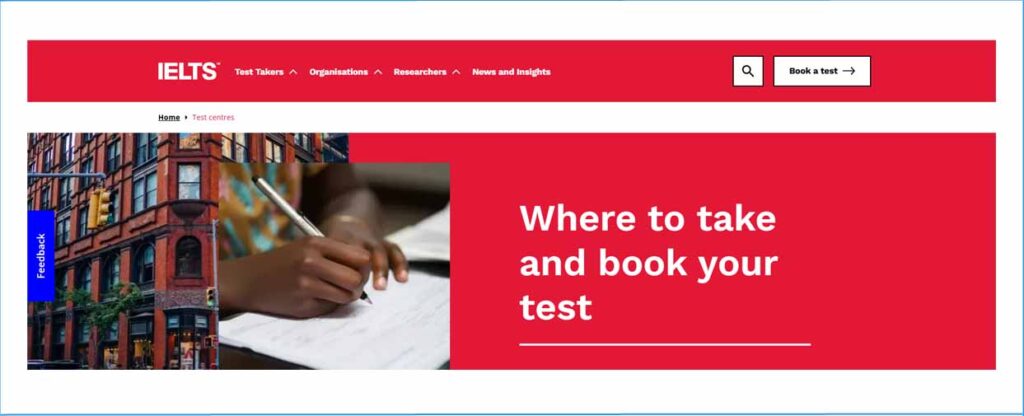
2. Select your test centre by choosing your country/territory and city.
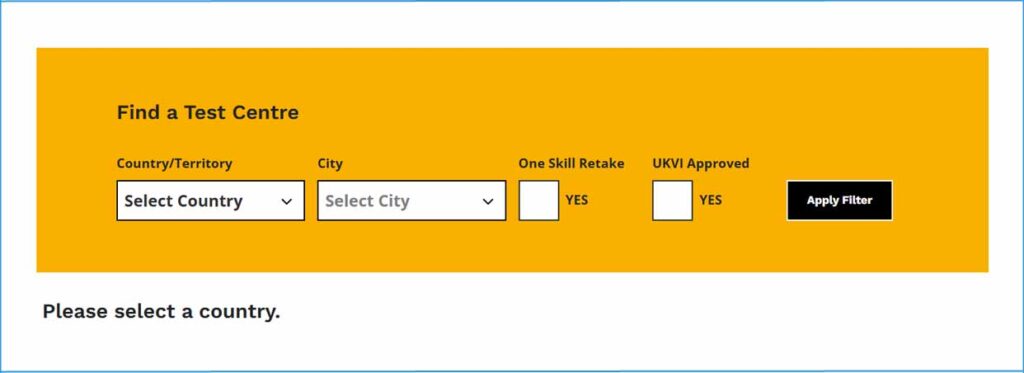
3. Click on ‘Book A Test’ to choose an available test from the provided list.
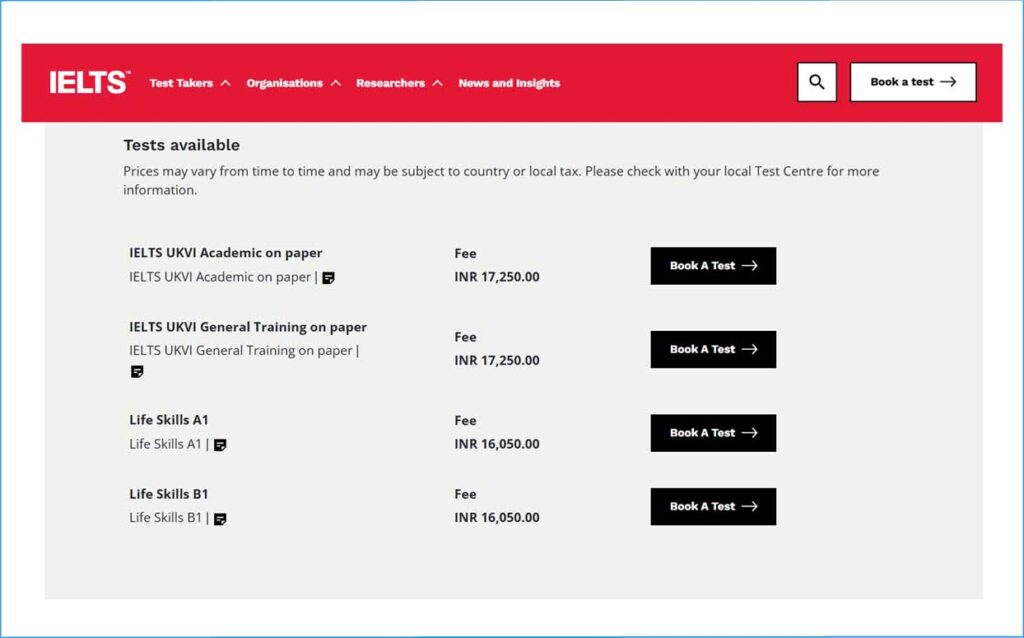
4. Select your test type, module, and preferred city for the exam, then click ‘Book Now’.
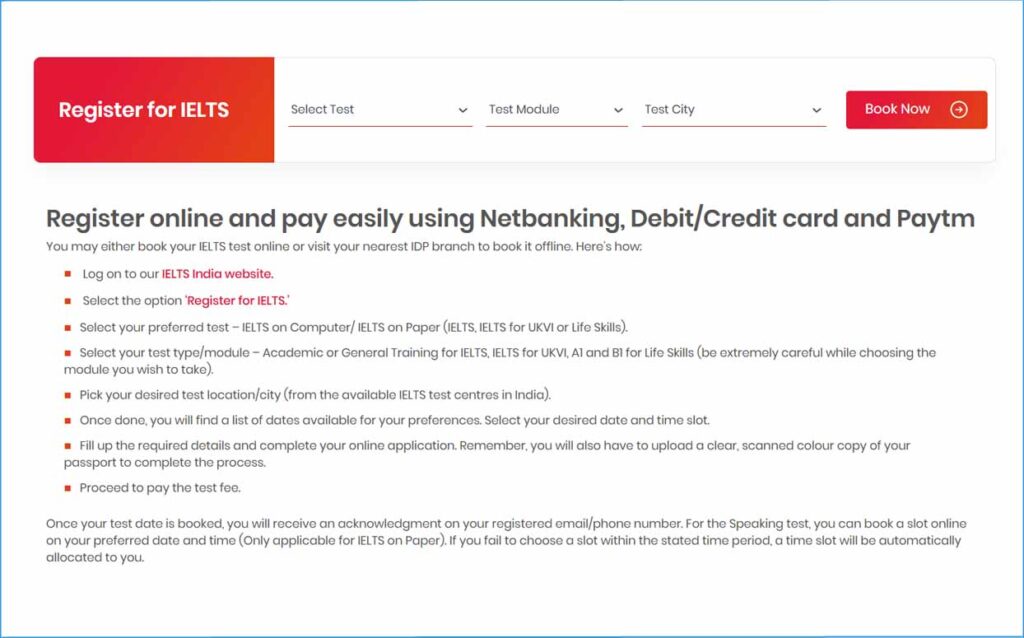
5. View available time slots and associated fees. Select your preferred slot and click “Book Now”.
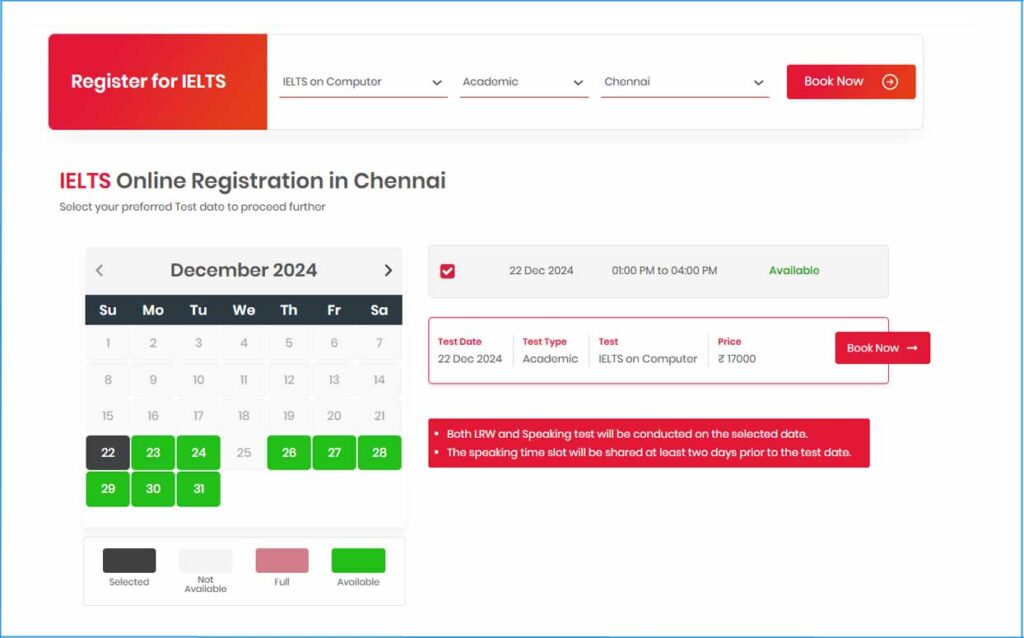
6. Complete the registration form, review your details, and proceed to payment.
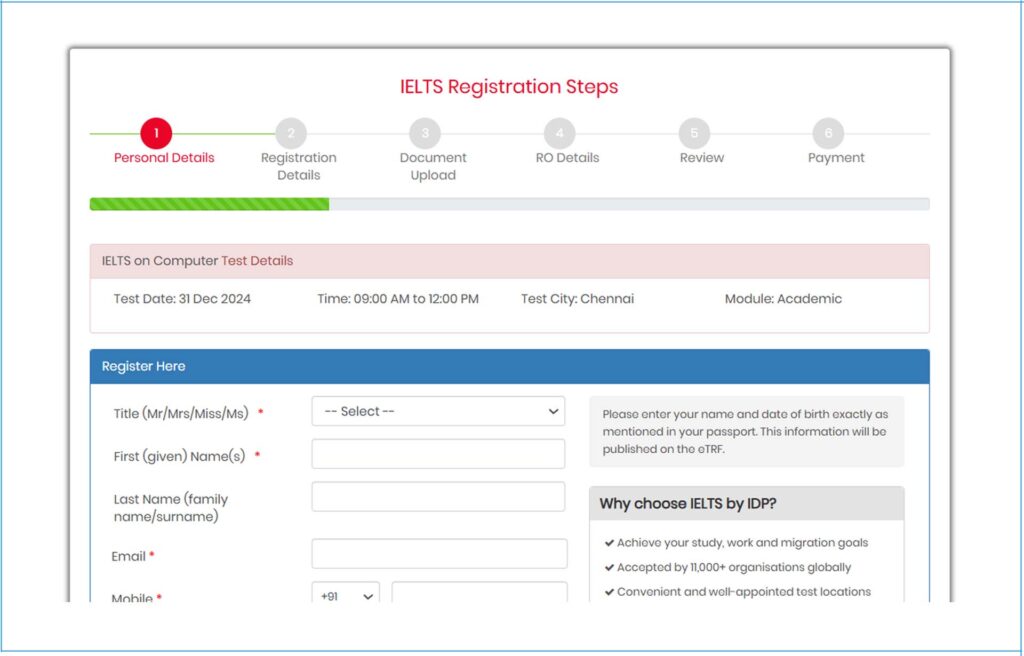
7. Upon completing registration, you will receive a confirmation email with your IELTS exam details.
Note: Your speaking time slot will be communicated at least two days before the test date.
Important Dates and Deadlines for 2025
Key Details for IELTS 2025
- IELTS tests are offered up to four times a month, typically on Thursdays and Saturdays.
- Bookings for 2025 tests are already open, and popular dates tend to fill up quickly—especially between May and August, when university application deadlines approach.
- Computer-delivered IELTS is available almost daily, giving you more flexibility if you’re aiming for faster results (typically within 3–5 days).
Suggested Timeline
| Target Study Intake | Recommended IELTS Test Window | Why This Timing Works |
|---|---|---|
| September 2025 Intake (Fall) | January to May 2025 | Gives you enough time for score reporting, applications, and visa processing. |
| January 2026 Intake (Spring) | August to October 2025 | Ideal for receiving results and applying for universities in time for the January session. |
Year-Round Accessibility
One of the most convenient aspects of IELTS is its flexible scheduling. The exam is offered up to four times a month, primarily on Thursdays and Saturdays, giving you over 48 paper-based test dates annually across multiple locations in India.
If you prefer faster results and a wider range of test slots, Computer-delivered IELTS is available almost every day, including weekends, at select centres. This makes it easier to align your test with university deadlines, visa timelines or your personal study plan.
Whether you’re planning months in advance or need a last-minute booking, the test’s frequency ensures that there’s always a date that suits your schedule.For the whole list of dates, you can visit the official IELTS website.
Module-Specific Availability in India
When booking your IELTS test, it’s important to note that availability differs between the Academic and General Training modules in India.
- Academic Module: This is offered on all 48 test dates throughout the year, ensuring ample flexibility for students planning to apply to universities abroad.
- General Training Module: Typically available on 24 test dates annually, usually twice a month. This is ideal for those appearing for migration or work purposes.
This distinction helps ensure that Academic test-takers—who usually face tight university application deadlines—have broader scheduling options. Meanwhile, General Training candidates still benefit from regular opportunities across the year.
Tip: Always check date availability while booking, as some locations may offer fewer General Training slots due to local demand.
Convenient Scheduling
Test Day Structure
- Listening, Reading and Writing: These three sections are conducted back-to-back on the same day, usually in the morning. This helps ensure a seamless experience without breaks that could disrupt focus.
- Speaking: The Speaking test may be scheduled up to seven days before or after the main test date, depending on the availability at your chosen test centre. If you opt for IELTS on Computer, Speaking slots are often more flexible and can even be selected at the time of booking.
Peak Season Demand
Tip: Avoid last-minute scheduling, especially during admission cycles or visa rush seasons. Booking 4–6 weeks ahead can give you more control over your test day preferences.
Registration Deadlines
Booking your IELTS test at the right time can make a significant difference to your preparation and peace of mind. While you can register for an IELTS test up to one week before the test date, slots tend to fill up quickly—especially in metro cities and during peak periods.
Recommended Timeline
To avoid last-minute hassles and limited slot options, it’s advisable to register at least 6–8 weeks in advance. For high-demand months like March–April and August–December, aim to book your test 2–3 months ahead, particularly if you have visa, university or scholarship deadlines to meet.
Peak Season Note
Fees and Payment Methods
- Test Fee: The cost of the IELTS exam varies by location and test type but typically ranges from INR 11000 to INR 18000.
For 2025, the the IELTS exam fees for different cities are tabulated below:
| City | IELTS Exam Fee (2025) |
|---|---|
| Hyderabad | INR 17,000 |
| Delhi | INR 17,000 |
| Bangalore | INR 17,000 |
| Chennai | INR 17,000 |
| Mumbai | INR 17,000 |
| Punjab | INR 17,000 |
| Pune | INR 17,000 |
| Kerala | INR 17,000 |
| Kolkata | INR 17,000 |
| Ahmedabad | INR 17,000 |
Refund and Rescheduling Policy
- Cancellation: You can cancel up to 5 weeks before the test date to receive a refund, minus an administrative fee.
- Rescheduling: Requests made more than 5 weeks in advance are generally allowed with an administrative charge. Rescheduling within 5 weeks of the test date is permitted only in cases of serious medical or compassionate grounds, supported by valid documentation.
The following is a list of the IELTS test fees for India in 2025, based on the types of tests.
| IELTS Test Type | IELTS Test Fee 2025 |
|---|---|
| IELTS on Computer for UKVI | INR 17,250 |
| IELTS on Computer | INR 17,000 |
| IELTS Life Skills (A1 and B1) | INR 16,050 |
| IELTS for UK Visas and Immigration | INR 17,250 |
| Pen and Paper-based IELTS | INR 17,000 |
Payment Methods: You can pay via credit/debit card, PayPal, or bank transfer.
Preparation Tips for the IELTS Exam
Effective IELTS preparation begins with a clear understanding of the test format and question types across all four sections. Building strong reading, listening, writing and speaking skills takes time, so it’s essential to follow a structured study plan tailored to your strengths and weaknesses. Use trusted resources and official sample papers to familiarise yourself with the exam style and level of difficulty.
Consistency is key—practise regularly under timed conditions, revise your answers critically, and monitor your progress through mock tests. Expanding your vocabulary, improving grammatical accuracy, and staying engaged with English through media or conversations can significantly boost your confidence and performance. With focused preparation and the right strategy, achieving a high band score becomes a realistic goal.
Effective Study Strategies
Preparing for the IELTS requires both discipline and direction. Start by setting a realistic study schedule based on your target test date—ideally 8 to 12 weeks in advance. Dedicate time each week to all four sections, gradually increasing your focus on weaker areas as you progress.
Structure your plan around regular reading and listening practice, timed writing tasks, and mock speaking sessions. Prioritise quality over quantity: even an hour of focused, distraction-free study each day can lead to significant improvement. Use official IELTS materials to stay aligned with the test format and level, and track your performance through periodic mock tests.
If possible, join a study group or attend coaching sessions to gain new perspectives and feedback. Staying consistent and reflective in your approach is key to building the confidence and skillset needed to excel on test day.
Importance of Practice Tests and Time Management
Consistent practice with full-length IELTS tests is essential for building both familiarity and confidence. Resources like the IDP IELTS Practice Tests, Cambridge IELTS series, and the British Council’s online mock tests offer realistic simulations that mirror the actual test environment. These not only help you track your progress but also improve your comfort with the test structure.
Time management is equally critical. Begin by timing each section individually, then progress to full timed mocks. Use tools like IELTS-specific timers and answer sheets to replicate real conditions. For Writing and Reading, train yourself to allocate time per task or passage—this reduces last-minute rushes. With Speaking, practise within the allowed minutes using cue cards and voice notes. Gradually, you’ll build the speed and precision needed to navigate the test confidently and finish every section on time
Tips for Improving Skills in Each Section
- Listening: Diversify your practice by tuning into podcasts, TED talks, and radio programmes on various topics. Try summarising key points after each listening session to enhance comprehension. Additionally, work on recognising different accents and note-taking during audio clips to simulate exam conditions.
- Reading: Broaden your reading sources, from academic articles and newspapers to fiction and non-fiction books. Focus on practising skimming for main ideas and scanning for specific details under timed conditions. Try answering questions on inference and writer’s opinion to sharpen critical reading skills.
- Writing: Regularly draft essays, reports and letters on diverse subjects, paying attention to structure, coherence and vocabulary. Seek feedback from teachers or peers and revise accordingly. Also, practise planning your essays within 5-7 minutes to build speed without compromising clarity.
- Speaking: Engage in conversations on everyday and abstract topics with native speakers or fellow learners. Record your responses to typical IELTS questions and critically assess your fluency, pronunciation and grammatical accuracy. Role-play scenarios like interviews or discussions to boost confidence and spontaneity.
IELTS Scoring System
Explanation of the IELTS Band Score System
Band Score Descriptions
| Band Score | Skill Level | Description |
|---|---|---|
| 9 | Expert User | Has fully operational command of the language: appropriate, accurate, and fluent with complete understanding. |
| 8 | Very Good User | Has fully operational command of the language with only occasional unsystematic inaccuracies and inappropriate usage. |
| 7 | Good User | Has operational command of the language, though with occasional inaccuracies, inappropriate usage, and misunderstandings in some situations. |
| 6 | Competent User | Has generally effective command of the language despite some inaccuracies, inappropriate usage, and misunderstandings. |
| 5 | Modest User | Has partial command of the language, coping with overall meaning in most situations, though is likely to make many mistakes. |
| 4 | Limited User | Basic competence is limited to familiar situations. Has frequent problems in understanding and expression. |
| 3 | Extremely Limited User | Conveys and understands only general meaning in very familiar situations. Frequent breakdowns in communication occur. |
| 2 | Intermittent User | No real communication is possible except for the most basic information using isolated words or short formulae in familiar situations. |
| 1 | Non-User | Essentially has no ability to use the language beyond possibly a few isolated words. |
| 0 | Did not attempt the test | No assessable information was provided. |
How Each Section is Scored
The IELTS scoring system differs between the test sections to best capture your language abilities.
For the Listening and Reading sections, scoring is straightforward: each correct answer earns one mark. The total number of correct responses is then converted into a band score on the nine-band scale. This conversion accounts for varying levels of difficulty across test versions, ensuring fairness and consistency. Essentially, your raw score out of the total questions translates into a band that reflects your comprehension skills accurately.
In contrast, the Writing and Speaking sections are assessed more holistically. Expert examiners evaluate your performance based on several detailed criteria. For Writing, this includes how well your ideas are organised and linked together (coherence and cohesion), the range and accuracy of your vocabulary, the variety and correctness of your grammatical structures, and how effectively you address the task. Similarly, in the Speaking test, assessors consider your fluency and coherence, lexical resource, grammatical range and accuracy, and pronunciation.
Because these sections measure productive language skills, the scoring is more subjective and focuses on your ability to communicate clearly and effectively, rather than simply providing ‘correct’ answers. This balanced evaluation helps ensure your overall band score genuinely reflects your English proficiency.
Overall Band Score Calculation
- Example 1
Listening: 7.0 | Reading: 6.5 | Writing: 6.0 | Speaking: 7.5
Average score = (7.0 + 6.5 + 6.0 + 7.5) / 4 = 6.75 → Overall Band Score: 7.0 - Example 2
Listening: 6.5 | Reading: 6.5 | Writing: 6.0 | Speaking: 6.0
Average score = (6.5 + 6.5 + 6.0 + 6.0) / 4 = 6.25 → Overall Band Score: 6.5 - Example 3
Listening: 8.0 | Reading: 8.0 | Writing: 7.5 | Speaking: 7.5
Average score = (8.0 + 8.0 + 7.5 + 7.5) / 4 = 7.75 → Overall Band Score: 8.0 - Example 4
Listening: 6.0 | Reading: 6.0 | Writing: 6.0 | Speaking: 6.0
Average score = (6.0 + 6.0 + 6.0 + 6.0) / 4 = 6.0 → Overall Band Score: 6.0
Required Scores by Universities and Employers
- University of Oxford usually asks for an overall band score of 7.0, with no less than 6.5 in each section for most postgraduate courses.
- University of Cambridge requires a minimum of 7.5 overall for some courses, especially in law and medicine.
- London School of Economics (LSE) generally expects a 7.0 overall, with at least 7.0 in writing and speaking.
Test Day Guidelines
Being well-prepared for test day is crucial to remain calm and confident throughout the IELTS exam. Arrive at the test centre at least 30 minutes early to allow time for registration and security checks. Remember to carry your original identification document—the same one you used to register—as it is mandatory for entry.
Dress comfortably and check the weather in advance, as some test centres may require waiting outdoors. Avoid bringing valuables or electronic devices, including phones, as these are typically prohibited inside the exam room. Test centres provide clear instructions about allowed items, so it’s best to follow these carefully.
The IELTS Listening, Reading and Writing sections are completed on the same day, with short breaks in between. Your Speaking test may be scheduled on the same day or within a week before or after, depending on the centre’s arrangements. Make sure you know your Speaking test date and location well in advance.
During the exam, read instructions thoroughly and manage your time wisely. If you have questions or face any issues, inform the invigilator immediately. Staying calm and focused will help you perform at your best.
Finally, after completing all sections, confirm how and when your results will be issued and where you can access them. Understanding these details ahead of time can save unnecessary stress.
What to Expect on the Day of the Exam
On the day of your IELTS exam, plan to arrive at the test centre at least 30 minutes before your scheduled start time. This allows you enough time to complete check-in procedures without feeling rushed. When you arrive, you will be required to present your original identification document along with your confirmation email or registration details. Be prepared for a photograph to be taken as part of the security process.
Once checked in, you will be directed to the test room and assigned a seat. The centre will provide you with all necessary stationery, such as pencils and erasers. Personal items like mobile phones and bags are generally not allowed in the exam room, so follow the centre’s instructions on where to store these securely.
Before the test begins, the invigilator will give clear instructions and guidelines. It is important to listen carefully, as any announcements or clarifications will help you avoid confusion during the exam. You will also have a chance to ask questions if anything is unclear.
The exam itself is structured to flow smoothly, with the Listening, Reading and Writing sections completed consecutively on the same day. Short breaks are usually given between sections. If your Speaking test is scheduled separately, make sure you know the exact time and location, as it may be on a different day or at a different venue.
Keeping calm, staying hydrated and maintaining focus throughout the day can greatly enhance your performance. Knowing exactly what to expect helps reduce anxiety and lets you concentrate fully on demonstrating your English skills.
Items to Bring and Prohibited Items
Items to Bring:
- Valid ID (passport or national ID)
- Pencils and erasers (if not provided by the test centre)
Please note that: You must present the same identification document that you used on your IELTS application form. Without the correct ID, you will not be permitted to take the test.
Prohibited Items:
- Mobile phones and electronic devices (including personal watches).
- Personal items such as bags and wallets (these must be left outside the test room)
- Notes, books, and any other unauthorised materials
Tips for Managing Exam-Day Nerves and Staying Focused
- Get Adequate Rest Ensure a good night’s sleep before the exam to enhance concentration and reduce anxiety.
- Eat a Nutritious Breakfast Choose balanced meals with protein and complex carbs to maintain steady energy levels.
- Stay Hydrated Drink plenty of water to keep your mind alert and body functioning optimally.
- Practice Deep Breathing Use slow, controlled breaths to calm nerves and lower stress.
- Use Positive Visualisation Imagine yourself confidently completing each section to boost self-assurance.
- Stay Present and Focused Concentrate on the current section, avoid dwelling on past answers or time pressure.
- Take Brief Mental Pauses If distracted, pause for a moment and gently redirect your focus to the task.
- Accept Nervousness as Normal View some anxiety as natural and channel it to stay alert rather than overwhelmed.
FAQ
Registration
It’s recommended to register at least 3-4 months in advance to secure your preferred test date and location.
Yes, you can change your test date after registering. However, please note that if your request to change the test date is made close to the original test day, it might be considered a cancellation.
You will need a valid passport or national ID. Ensure the document you use for registration is the same one you bring on test day.
Preparation
Use a combination of official practice materials, study groups, and mock tests. Focus on improving your skills in each section.
Preparation time varies, but most candidates spend 2-3 months preparing for the exam, dedicating several hours each week to study and practice.
Yes, there are numerous free resources available, including practice tests, sample questions, and study guides on the official IELTS website and other educational platforms.
Test Day
Late arrivals may not be allowed to take the test. It’s crucial to arrive on time to avoid missing the exam.
Yes, you can bring a transparent bottle of water. Make sure it has no labels or writing on it.
If you feel unwell on the test day, inform the test centre staff as soon as possible. You may be able to reschedule your exam for a later date with a valid medical certificate.
IELTS results are typically available 13 days after the test date. You can view your results online or receive a Test Report Form (TRF) by mail.
Scoring
Yes, if you believe your scores do not reflect your performance, you can request an Enquiry on Results (EOR) within six weeks of your test date. There is a fee for this service, which is refunded if your scores change.
Yes, IELTS scores are valid for two years from the test date. After this period, the scores expire and are no longer considered valid for admissions, visa applications, or other purposes.
Conclusion
In this comprehensive guide, we’ve explored every essential aspect of the IELTS exam—from understanding the test format and registration process to proven preparation strategies and crucial test day tips. Achieving a strong IELTS score is a vital step towards unlocking educational and career opportunities in English-speaking countries worldwide.
Success in IELTS demands dedicated preparation, consistent practice, and smart use of reliable resources. By staying focused and following the strategies outlined here, you are well on your way to reaching your target score.
Ready to take the next step? Whether you’re just starting your IELTS journey or aiming to boost your current score, begin your preparation today with confidence. For personalised guidance and expert support tailored to your goals, reach out to Fateh Education — your trusted partner in achieving IELTS success.
Best of luck on your IELTS journey. Your dream opportunities await!

